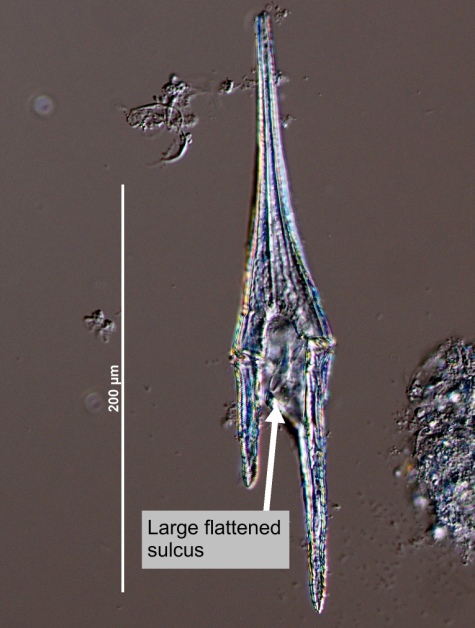





|
Synonym(s)
(Montagnes 2006)
Classification
(Guiry and Guiry 2012)
Lifestyle
Description
Girdle
In diatoms, the portion of the cell wall between the two valves of a cell; made up of intercalary bands (bands closest to the valves) and connecting bands (bands in the middle of the girdle). In dinoflagellates, the equivalent of a cingulum or transverse furrow (Horner 2002).
girdle and a prominent straight CloseApical
(axis, spine) The region of the apex or point. Refers to the most anterior point or region of the cell (HPP 2003).
apical horn (Montagnes 2006). C. furca also has two unequal posterior horns. The right horn is shorter than the left (Montagnes 2006). There is a thin bar that connects the two horns (Montagnes 2006). C. furca is yellow-brown and has thick thecal plates (Kraberg et al. 2010).Measurements
Width: 30 - 35 μm
(Montagnes 2006)
Similar species
Harmful effects
Anoxic
Describing a condition where there is no available oxygen for primary production. Oxygen may be present in complexed forms that are not available for phytoplankton. A related term is hypoxia, where oxygen is present at very low concentrations.
anoxic conditions (Morton et al. 2011).Habitat
Estuary
The area where a river meets the ocean. Often characterized by high sediments, high nutrient levels, salinity fluctuations and tidal mixing.
estuaries (Horner 2002).Distribution
Ceratium furca is a cosmopolitan in cold temperate to tropical waters (Horner 2002). Blooms have been reported in in Japan and the Americas (Montagnes 2006). This species is also found in the Mediterranean and the North Sea (Montagnes 2006).
Blooms in late summer to autumn (Kraberg et al. 2010).
Growth conditions
Diel vertical migration
(DVM) A daily vertical migration through the water column. Most commonly, this is used to describe zooplankton that spend their days at depth to avoid predators and spend their nights at the surface feeding on phytoplankton. This is called nocturnal DVM and the opposite (surface during the day, maximum depth during the night) is called reverse DVM (Selph 2009).
diel vertical migration (DVM) as an ecological adaptation to avoid high light levels at the surface during the day (Baek et al. 2011). This species is also believed to have an advantage over other Ceratium species in phosphorous-limited environments (Morton et al. 2011).Environmental Ranges
Temperature range (°C): -1.405 - 26.001
Nitrate (μmol L-1): 0.135 - 28.280
Salinity: 13.035 - 37.775
Oxygen (mL L-1): 4.705 - 8.041
Phosphate (μmol L-1): 0.048 - 2.337
Close
Silicic acid
A general term to describe chemical compounds containing silicon, oxygen and hydrogen with a general formula of [SiOx(OH)4-2x]n. Diatoms polymerize silicic acid into biogenic silica to form their frustules (Azam and Chisholm 1976).
Silicate (μmol L-1): 0.648 - 59.039(EOL 2012)
Bloom characteristics
References
Baek, S. H., Hoshin, H., Woo-Choi, H., Shimode, S., Hwang, O. M., Shin, K. and Kim, A. Y. 2011. Ecological Behaviour of the dinoflagellate Ceratium furca in Jangmok Harbor of Jinhae Bay, Korea. Journal of Plankton Research. 33(12): 1842-1846.
Encyclopedia of Life (EOL). 2012. Ceratium furca (Ehrenberg) Claparede and Lachmann 1859. http://eol.org/pages/903700/details. Accessed 19 Jan 2012.
Guiry, M. D. and Guiry, G. M. 2012. Ceratium furca (Ehrenberg) Claparede and Lachmann 1859. http://www.algaebase.org/search/species/detail/?species_id=52149. Accessed 19 Jan 2012.
Horner, R. A. 2002. A Taxonomic Guide To Some Common Phytoplankton. Biopress Limited, Dorset Press, Dorchester, UK. 200.
Kraberg, A., Baumann, M. and Durselen, C. D. 2010. Coastal Phytoplankton Photo Guide for Northern European Seas. Verlag Dr. Friedrich Pfeil, Munchen, Germany. 203.
Montagnes, D. 2006. Guide to Harmful Phytoplankton. http://www.liv.ac.uk/hab/Data%20sheets/c_furc/c_furc.pdf. Accessed 19 Jan 2012.
Morton, S. L., Shuler, A., Paternoster, J., Fanolua, S. and Vargo, D. 2011. Coastal eutrophication, land use changes and Ceratium furca (Dinophyceae) blooms in Pago Pago Harbor, American Samoa 2007-2009. Chinese Journal of Oceanology and Limnology. 29(4): 790-794.
Kuylensterna, M. and Karlson, B. 2006. Ceratium furca (Ehrenberg) Claparède et Lachmann 1858. http://www.smhi.se/oceanografi/oce_info_data/plankton_checklist/dinoflagellates/ceratium_furca.htm. Accessed 18 Jan 2012.
Scott, F. and Brandt, S. 2011. Ceratium fusus (Ehrenberg) Dujardin 1841. http://www.marinespecies.org/aphia.php?p=taxdetails&id=109951. Accessed 03 April 2012.
